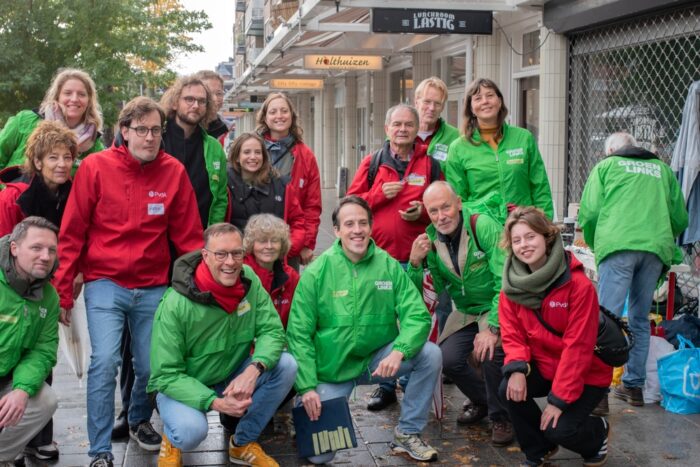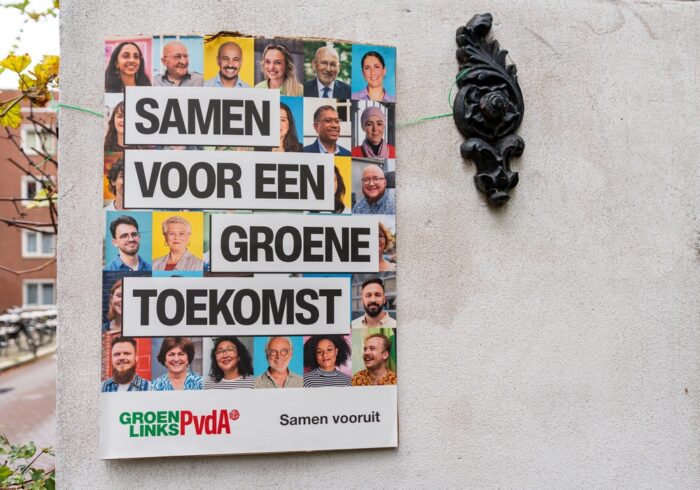The Progressive Post
Shift to the right and lack of perspectives

The outcome of the Swiss federal elections is characterised by a relative stability typical of the Swiss political system. However, the Swiss parliament shifts further to the right. Within the red-green bloc, the Social Democratic Party made slight gains, while the Greens suffered significant losses. Unfortunately, no hopeful future perspective is apparent.
The clear winner of the elections is the right-wing Swiss People’s Party (SVP). The strongest party (since 1999) gained three per cent of the vote (now 28.6 per cent), securing 62 of the 200 seats in the National Council (an increase of nine seats). This allowed the SVP to recover from its losses in the previous elections. On the other end of the spectrum, the Green Party, which now holds 9.4 per cent of the vote (a decrease of 3.8 per cent), looses five of its 28 seats and is demoted after its significant electoral success four years ago.
The Social Democratic Party (SP) has achieved a new vote share of 18 per cent (+1.2 per cent) and gained two seats (now 41 seats) in the National Council. Among the centrist parties, there were minor shifts: The Centre Party (former Christian Democratic People’s Party) gained ground (plus 0.8 per cent), while the Radical-Liberal Party (FDP) (minus 0.7 per cent) and the Green Liberal Party (minus 0.6 per cent) suffered losses. The Centre Party is likely to play an even more important role in securing majorities in the newly composed parliament. The question is how the party will position itself in the concrete political disputes to come.
In the Council of States, 15 of the 46 seats will only be allocated in the second round of voting. But even in the upper house, where the Centre Party and the FDP traditionally dominate, a – more moderate – swing to the right is expected. These are the most important election results. But what lies behind these changes in vote shares and seats? How can the overall result be interpreted, and what does it portend for the future? The following reflections attempt to place the Swiss federal election in the context of the current polycrisis, focusing primarily on the handling of the climate issue – and on the SVP.
Climate change: The elephant in the room
With the intensification of the climate crisis, it is becoming apparent that the situation is spiraling out of control, not just in 50 years, but maybe with the next heatwaves and tipping points, which are reached faster than expected. Nevertheless, climate change remained the elephant in the room during the election campaign. Of course, no party could avoid positioning itself on climate policy. Apart from the Greens, who were the major losers in the election, all other parties chose a rather defensive approach – or even a mainly distancing one: from climate activists or ‘climate hysteria’. There was no trace of the enthusiasm that surrounded the 2019 elections, dubbed the ‘climate election’, which led to significant gains for the Greens (and the Green Liberals).
For the SP, the priority was purchasing power, with gender equality and climate protection as secondary focal points. Given rising rents, healthcare costs (which are paid in Switzerland based on an unjust per-capita premium principle, not through taxes), and energy costs, this focus on the social question was likely tactically correct. However, the demand for increased purchasing power is inherently also a remnant of the ‘Fordist’ past. It essentially implies a commitment to the capitalist growth society and thus to a system that has gone out of control. It is not a progressive vision or a hopeful and at least partly plausible project for the future.
Fascism in Switzerland?
In recent years, there has been much discussion concerning the global rise of the ‘New Right’ and the success of right-wing populism. However, according to Berthold Franke of the Goethe-Institute, this analytical approach falls short. In an article in the Blätter für deutsche und internationale Politik, he advocates for a new concept of fascism that encompasses the present movements and regimes, including political figures like Putin, Trump, Erdoğan, Le Pen, Modi, Orbán, Meloni, Höcke and others.
Fascism emerges when the status quo is in crisis, and, as is the case today, there is a lack of convincing alternative visions of the future, a lack of hope for the future. It is the ‘offering for the disaffected, disillusioned, cheated, and frustrated of all classes and strata’, as Franke describes it. This offering is sought after, especially when it is promoted to the people with propaganda and emotional appeal by political parties. At this point, at the latest, the SVP comes into play. On a programmatic and communicative level, the party has been a pioneer and a model for right-wing populist or even fascist forces for years. In the recent election campaign, it stirred up sentiments, especially against immigrants, but also against the ‘climate dictatorship’, wokeness, and the ‘political elite’. It is also cosying up to authoritarian regimes. These are core elements of a contemporary fascist program. The SVP promises to protect an outdated, romanticised, and unsustainable way of life and effectively employs a powerful instrument of fascism: political nostalgia.
No, Switzerland is not a fascist country. Categorising the SVP as consistently fascist would also be inaccurate. The situation of the marginalised and the hopeless may often be less severe in wealthy Switzerland than in other countries (though the equally crucial perception of the situation is another matter). The Swiss consensus democracy, a system that tries to integrate all political forces, provides institutional protection against a fascist government. Another Swiss Sonderfall then? I wouldn’t be too sure. Global crisis developments are increasingly affecting Switzerland as well. The SVP, as the strongest party, is on a path of radicalisation. Contacts between SVP representatives and openly right-wing extremist or fascist circles regularly appear. The conservative parties in the center still prefer to distance themselves from the left rather than the right. These are patterns known from history.
Maintaining and expanding options for action
Pessimism often paralyses and prevents change, it is said. That may be true. However, a positive and realistic vision of the future that could offer a way out of the current polycrisis is not discernible. This ‘future vacuum’ is currently being filled worldwide by antidemocratic forces. So, where to draw the line between alarmism and naivety?
If we consider elections as a political moment in which the broad promotion of competing visions of the future is crucial, then the 2023 elections did not meet expectations. How could a desirable, a just and democratic future in a post-carbon world look like? Such visions are being developed within the left. Still, they were absent from the election campaign also this year. The centrist parties (including the Green Liberals) are refusing to confront reality, and they are deceiving people (and likely themselves) by suggesting that we will somehow emerge from the mess we’re in through technology and a calm management of the status quo. Meanwhile, the SVP is accentuating its destructive course. On this dystopian path, we not only abandon the chance to mitigate climate change but also solidarity and democracy. Ultimately, it leads to fascist conditions. This is not happening overnight, but step by step. The 2023 elections were one such step. The left must do everything in its power to prevent further steps. Every political battle won – inside and outside parliament – against the destroyers on the right can maintain future options for action on a warming planet and, in the best case, expand them. Currently, that seems to be the hope that remains.
Photo credits: Shutterstock.com/ Andriano.cz




